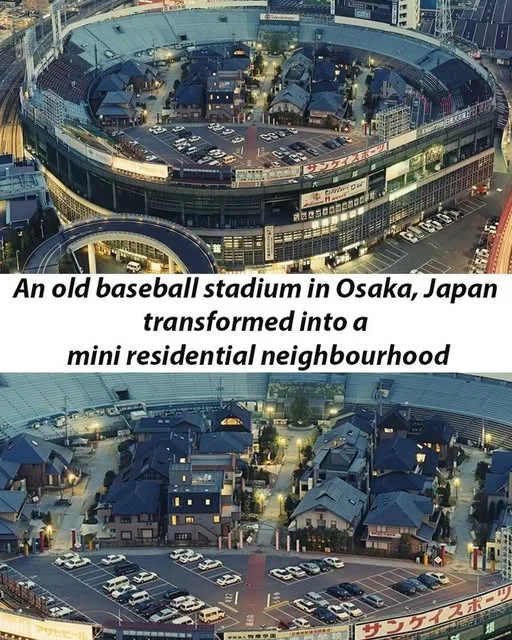Osaka Stadium’s Transformation: From Baseball to a Mini Residential Showcase
In the heart of Osaka, Japan, the former Osaka Stadium underwent a fascinating transformation that briefly turned its abandoned grounds into a mini residential neighborhood, complete with fake streets, street lights, and cars parked outside model homes. Opened in 1950 with a capacity of 32,000, this iconic venue served as the home of the Nankai Hawks baseball team until their relocation to Heiwadai Stadium in 1988. After the Hawks’ departure, the stadium was sold to Fukuoka City, marking the beginning of its unusual repurposing journey as of 05:52 AM MDT on Monday, July 7, 2025.

Historical Context
Osaka Stadium, built over the ruins of a World War II-damaged tobacco plant, was a cultural landmark, hosting professional baseball, high school championships, and even concerts by global stars like Madonna in 1987. Following the Nankai Hawks’ move, the Kintetsu Buffaloes temporarily used the stadium for a dozen games, with the last professional match drawing 29,000 fans on August 2, 1990. As part of the Namba district redevelopment project, the stadium’s demolition was planned, but its immediate future took an unexpected turn. Left vacant, it became a canvas for innovation rather than a prompt teardown.
The Mini Residential Experiment
In 1991, a trade group leased the stadium, converting its playing field into the “Namba Osaka Stadium Housing Fair,” an outdoor exhibition of model homes by various construction companies. The entire arena was reimagined as a miniature residential neighborhood, featuring neatly arranged rows of houses, artificial streets lined with street lights, and cars positioned outside to mimic a lived-in community. Lights were turned on to enhance the illusion of occupancy, creating a surreal spectacle captured in photographs by artists like Naoya Hatakeyama in 1998.
This setup was not a permanent residential area but a marketing ploy to showcase Western-style housing to potential buyers. However, the experiment faltered—local interest waned due to a preference for traditional Japanese architecture and perceived subpar construction quality, as noted by photographer Ned Bunnell, who observed the site’s emptiness during visits. The housing expo lasted until the late 1990s, when the stadium was demolished, making way for the modern Namba Parks office and shopping complex, completed by 2007.
Cultural and Practical Significance
The transformation highlights a creative, if short-lived, attempt to repurpose an aging sports venue amid urban redevelopment. It reflects Japan’s post-war experimentation with space utilization, though the failure underscores cultural resistance to imported architectural styles. The idea of integrating residential or commercial spaces into stadiums has since inspired global discussions—examples like Indianapolis’s Stadium Lofts show successful conversions—but Osaka’s effort remained a temporary display rather than a functional neighborhood.
Skepticism surrounds the narrative of its success, with some sources clarifying it was never intended as a true housing project, countering social media claims of a permanent residential shift. The staged setup, while visually striking, lacked the infrastructure for sustained living, suggesting it was more a bold marketing gimmick than a viable urban solution.
Preservation and Legacy
No physical remnants of the housing fair survive, as the stadium was razed in 1998. Its legacy lives on through photographs and online buzz, with posts found on X recently reviving interest, sparking nostalgia and debates about creative urban reuse. The site’s transformation into Namba Parks erased the original structure, but the story persists as a quirky footnote in Osaka’s history.
Conclusion
The old Osaka Stadium’s brief reincarnation as a mini residential neighborhood with fake streets, street lights, and parked cars from 1991 to the late 1990s was a bold, albeit unsuccessful, experiment in repurposing. Born from the abandonment of a 32,000-seat baseball icon, this housing fair showcased innovation but highlighted cultural mismatches. As of July 7, 2025, it remains a curious chapter in urban adaptation, reminding us of the challenges and creativity in reimagining spaces left behind by changing times.





